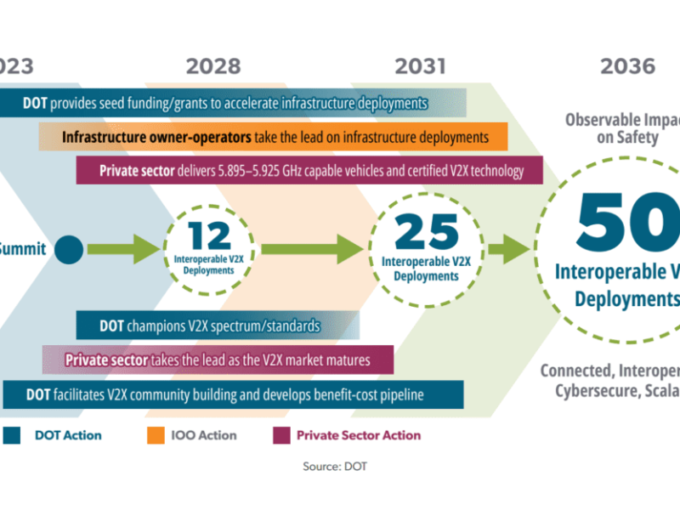The US department of transport has released its updated National Deployment Plan for Vehicle-to-Everything (V2X) technologies
The V2X plan, titled Saving Lives with Connectivity: A Plan to Accelerate V2X Deployment, is intended to guide the implementation of V2X technologies across the US.
The plan was initially released in draft form for public comment in October of last year, and the updates includes 5G and non-terrestrial network technologies alongside the DSRC protocol at 5.9GHz.
The aim is to have 12 interoperable, cybersecure deployments by 2028 with over 50 by 2036. These will use chips from three suppliers, expected to be Qualcomm and Autotalks as well as Renesas, and equipment from two.
The US government has been looking into V2X technology suppliers. The 5G Automotive Association (5GAA), Institute of Transportation Engineers (ITE), Intelligent Transportation Society of America (ITS America) and National Electrical Manufacturers Association (NEMA) note that the recent Advanced Notice of Proposed Rulemaking in March 2024 does not intend to imply that lifesaving technologies such as vehicle-to-everything (V2X) communications are unsafe for use in the US but warn against holding back deployment of the technology.
“The Department has reached a key milestone today in laying out a national plan for the transportation industry that has the power to save lives and transform the way we travel,” said U.S. Secretary of Transportation Pete Buttigieg. “The Department recognizes the potential safety benefits of V2X, and this plan will move us closer to nationwide adoption of this technology.”
“The plan was drafted and advanced with collaboration across public and private partnerships. It provides stakeholders with vital information to enable a safe, efficient, and sustainable transportation system through the national, widespread deployment of interoperable V2X technologies. The plan will accelerate investment, research, and deployment in V2X “market certainty,” said Principal Deputy Assistant Secretary for Research and Technology and Chief Scientist Dr. Robert C. Hampshire.
Along with the National Plan, the Federal Highway Administration recently announced nearly $60 million in grants to three entities to promote the deployment of V2X technologies. These are Maricopa County in Arizona. The Texas A&M Transportation Institute in Houston and the Utah department of transport.
Maricopa County DOT will engage private and public agency partners to lead a largescale deployment of V2X technologies, relying primarily on 5.9 GHz communications, to connect 750 physical and virtual roadside units to an estimated 400 vehicle onboard units targeting transit, emergency, and freight fleets. The project will deploy Emergency Vehicle Preemption, Vulnerable Road User detection, Transit Signal Priority, and Freight Signal Priority applications in the Cities of Phoenix, Tolleson, Avondale and unincorporated Maricopa County, as well as along ADOT’s US 60. The project will utilize an enhanced version of USDOT’s V2X Hub, which employs the 5.9 GHz spectrum along with SCMS-enabled access to adjacent unlicensed Wi-Fi, conformant to all relevant FCC regulations and in compliance with V2X standards.
Maricopa County DOT will also use a mobile 5G edge computing network and Intelligent Message Platform to connect virtual roadside units to onboard units and municipal and state infrastructure at 75 intersections, demonstrating interoperability between the 5.9GHz ITS spectrum and cellular network platforms. Furthermore, the deployment will demonstrate multi-carrier interoperability through the implementation of a virtual private cloud connection between one carrier’s Mobile Edge Computing (MEC) and a 2nd carrier’s cloud platform.
For the Houston deployment, Flood Warning, Signal Phase and Timing (SPaT) Enabled-Intersections, Right Turn on Red Warning, Red Light Violation Warning, Wrong Way Driving Detection, Emergency Vehicle Response Time and Safety, Hurricane Evacuation, and Planned Special Events/Construction will be deployed. For the College Station deployment, SPaT-Enabled Intersections for VRU Identification and Protection, Traffic Signal Preemption and Priority, Enhanced Highway Construction Worker Safety, and Every Day a Game Day will be deployed.
The project will use existing installations at nearly 1,000 intersections in Houston and equip 30 new intersections in the City. Similarly, 35 new intersections in College Station surrounding the university will be equipped with cellular-V2X (C-V2X) 5.9 GHz technology. The deployment will also equip approximately 100 fleet vehicles, 100 personal vehicles, and 75-100 bicycles. Two Original Equipment Manufacturer (OEM) partners will also contribute test vehicles for operation in the area to help refine the message sets that would be broadcast to their vehicles.
A three-state deployment site across Utah, Colorado, and Wyoming covers a broad variety of population densities, demographics, jurisdictions, topography, and transportation facilities.
The deployment area covers all of Utah, the I-80 through the entire length of Wyoming, and major portions of Colorado, including the Denver Metro Area, I-70 from Denver to the Utah border, and I-25 through Colorado.
The project will install V2X units at 450 new signalized intersections and at an additional 300 sites along corridors in Utah and Colorado, equip an additional 20 intersections with detection and warning systems and equip 215 additional vehicles with on board units.
A few applications will use non-5.9 GHz communications methods, including satellite communications, developed in Wyoming, and cell communications for tracking some fleet vehicles such as incident management trucks and snowplows.
The plan was welcomed by the 5G Automotive Association (5GAA).
Cellular-vehicle-to-everything (C-V2X) technology allows cars, trucks and other vehicles to send important safety alerts with one another, with road infrastructure and with vulnerable road users securely and in real-time, with two complementary transmission modes (direct and mobile network communications).
“Today’s release establishes clear objectives for future public and private investments in V2X in U.S. road transportation networks,” said John F. Kwant, Executive Director, Americas, for 5GAA. “V2X technologies are key to enabling the deployment of connected motor vehicles and road-side infrastructure that can sharply reduce road fatalities, a key goal of the National Road Safety Strategy. “
The report is at https://www.its.dot.gov/research_areas/emerging_tech/pdf/Accelerate_V2X_Deployment_summary_final.pdf



Leave a comment